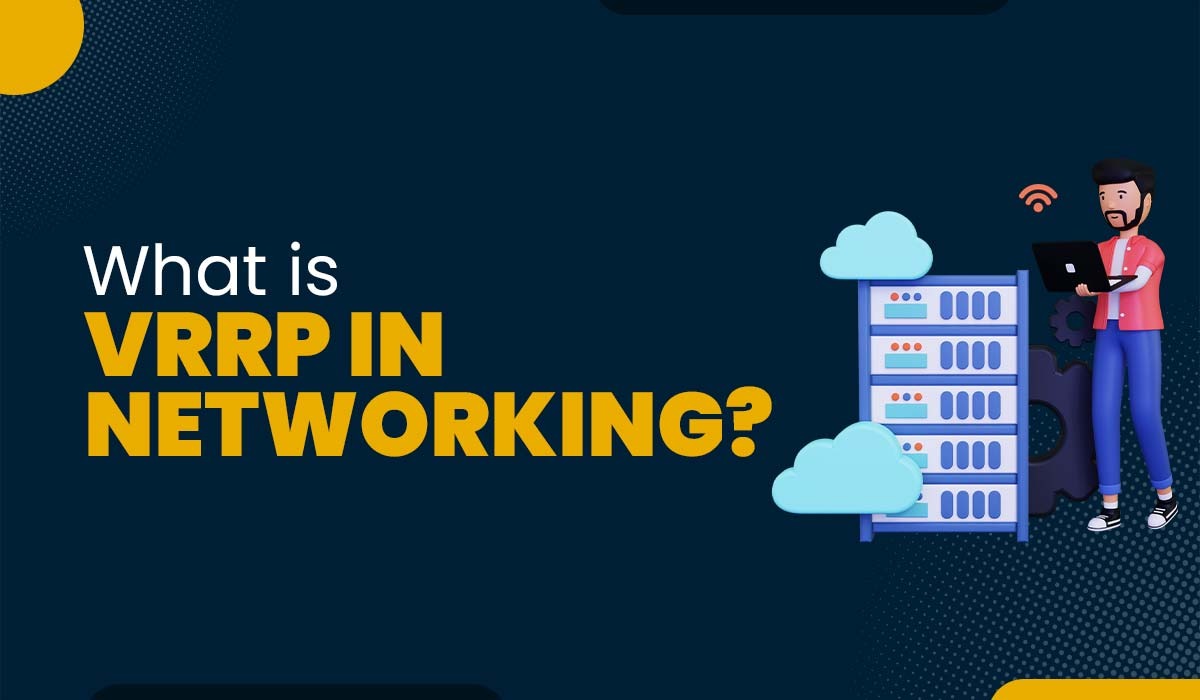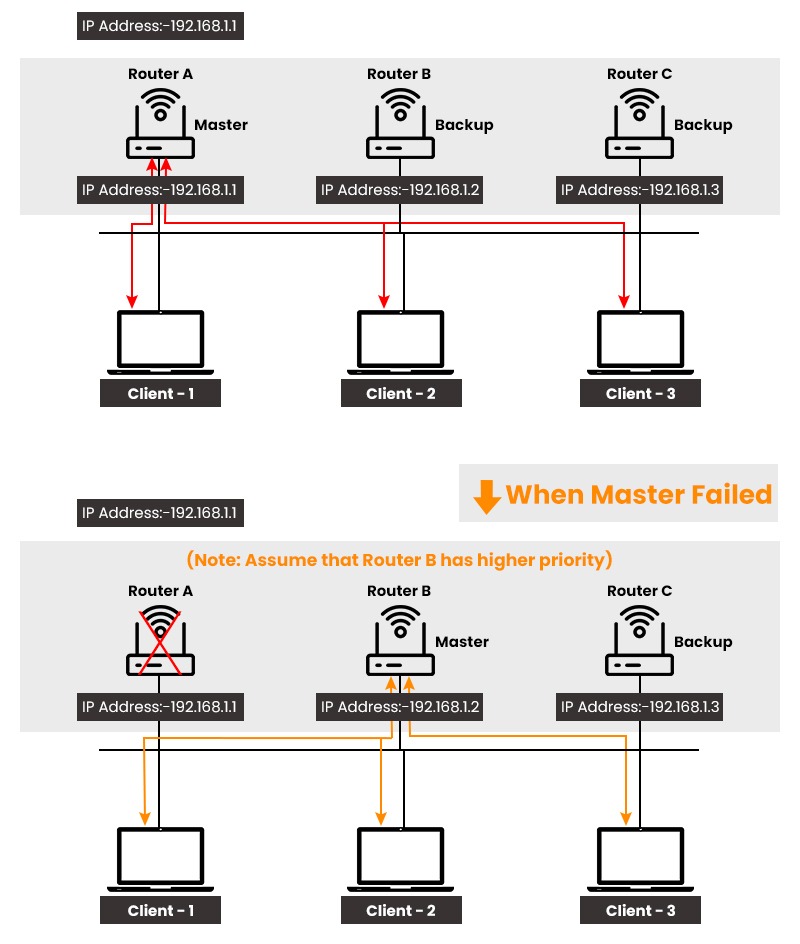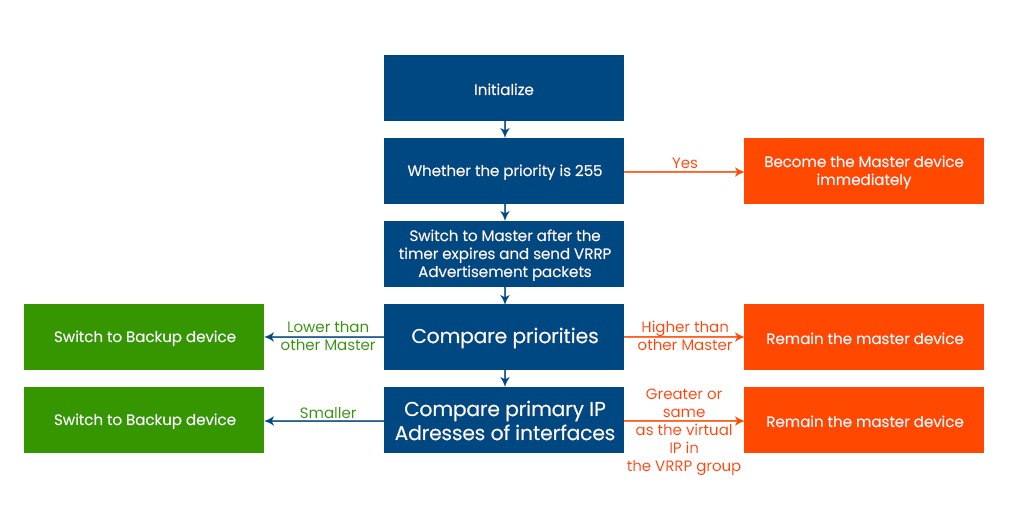What is VRRP in Networking?

VRRP stands for Virtual Router Redundancy Protocol, and it is a protocol that provides high availability and fault tolerance for routers in a network. It allows multiple routers to form a virtual router group and share a virtual IP address, which is used as the default gateway for the hosts in the network. In this blog post, we will explore what VRRP is, how it works, its components, advantages, and disadvantages. Before getting into more details, let’s first understand what it is. VRRP is a protocol that creates virtual routers, which abstractly represent multiple routers, i.e., primary/active/master and secondary/standby routers/backup, acting as a group. Virtual Router Redundancy Protocol enhances the availability of the default gateway that serves hosts within the same subnet. The implementation of VRRP enhances the dependability and efficiency of the host network by allowing a virtual router to function as the primary gateway for said network. It is a specialized protocol that allows the routing, forwarding, and switching of data within a group of virtual routers. It was developed as a solution to address the limitations of static addresses, which displayed ineffectiveness in situations where the route or path became inaccessible. It can be used in Ethernet, MPLS, and Token Ring networks with Internet Protocol Version 4 (IPv4) and IPv6. The term VRRP was first defined in RFC 2338 in 1998 as a standard protocol for providing redundancy in IP networks. It was mainly designed and developed to overcome the limitations of the protocols such as HSRP and GLBP, which were basically vendor-specific. In 2004, it was further updated in RFC 3768 to address the limitations and issues, such as using IPv6 and authentication methods. In 2010, it was further revised in RFC 5798 to add new features, mostly including preemptive modes, object tracking, and sub-second timers. Before getting into the working of VRRP, let’s first understand the different components that play important roles. Below we have discussed some of the important components of VRRP: VRRP uses a virtual IP address and a virtual MAC address for the virtual router. The virtual IP address is assigned from the local subnet and is configured as the default gateway for all the local hosts. The master router multicasts keep-alive messages to the backup routers every 1 second by default. This is called the master advertisement timer. The backup routers listen for these messages, and if they do not receive them for more than three times the advertisement timer, they assume that the master router is dead. This is called the master dead timer. When the master router fails, the backup routers initiate an election process to select the next master router based on its priority and IP address. The backup router with the highest priority becomes the new master router and starts forwarding packets using the virtual IP and MAC address. As you can see below, we have explained it with the help of an example. The election process can also be triggered by a preemption mechanism, which allows a backup router with higher priority than the current master router to take over as soon as it joins the network or recovers from a failure. Another mechanism that can influence the election process is object tracking, which allows the current master router to monitor its own state (such as line protocol or interface status) and lower its priority dynamically if it detects a fault. Below we have shown the election process for the master device. VRRP also supports three types of authentications: no authentication, plain text authentication, and MD5 authentication. Authentication ensures that only authorized routers can participate in a VRRP group and prevents spoofing attacks. We have discussed the working of VRRP in networking; let’s discuss the advantages and disadvantages that come with it. Some of the advantages of Virtual Router Redundancy Protocol are: Some of the disadvantages of Virtual Router Redundancy Protocol are: VRRP stands for Virtual Router Redundancy Protocol. It’s a way to make sure your network doesn’t go down if one of your routers fails. Basically, you have a group of routers that share the same IP address and act as one. One of them is the master, and the others are backups. If the master goes offline, one of the backups takes over and becomes the new master. Virtual Router Redundancy Protocol is an open standard protocol developed by IETF that is widely supported by various vendors and devices. HSRP stands for Hot Standby Router Protocol and is specifically developed for Cisco-oriented devices only. The Virtual Router Redundancy Protocol master device will transmit a message to the VRRP backup devices. The time that it takes to send the message from the master to the backup device is 1 second. After a certain amount of time without advertising, the backup device with the next highest priority becomes the master and starts packet forwarding. VRRP operates at layer 3 of the OSI model, the network layer. This means that Virtual Router Redundancy Protocol routers can communicate with each other using IP packets and can forward packets to other networks based on their destination IP address. VRRP is a useful protocol that provides for the automatic assignment of available IP routers to participating hosts. It is a quick and easy solution to create redundancy for IP routers in a network. This blog explained the VRRP in networking, its components, working, advantages, and disadvantages.Introduction
What is VRRP in networking?
History of VRRP
Components of VRRP in Networking
How does VRRP works?


Advantages of VRRP
Disadvantages of VRRP
Frequently Asked Questions
Q1 – What is VRRP, and how it works?
Q2 – What is the difference between VRRP and HSRP?
Q3 – What is the process of VRRP?
Q4 – Is VRRP l2 or l3?
Conclusion







